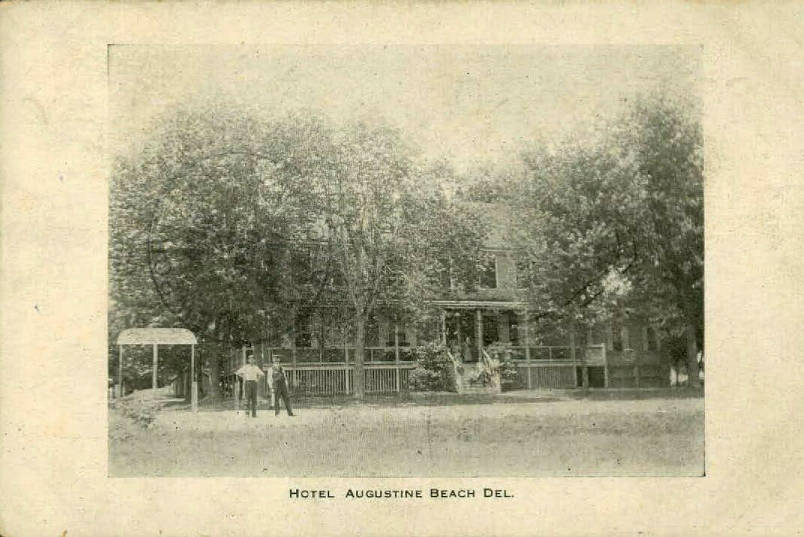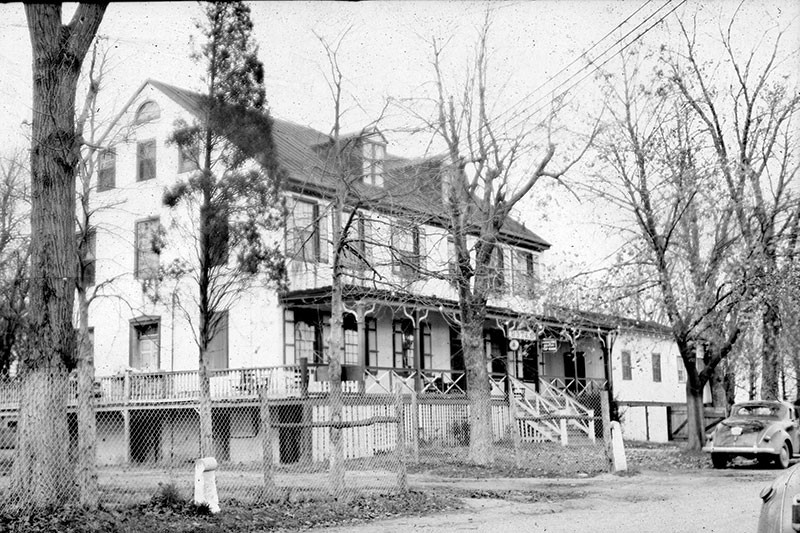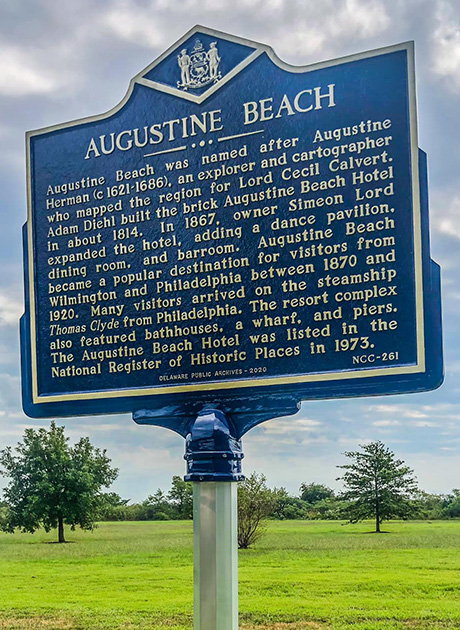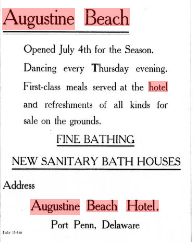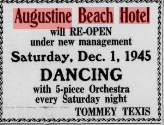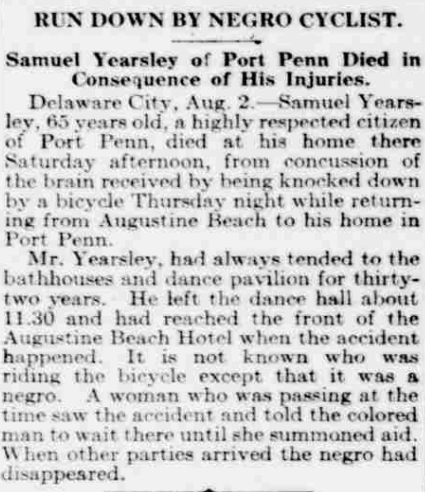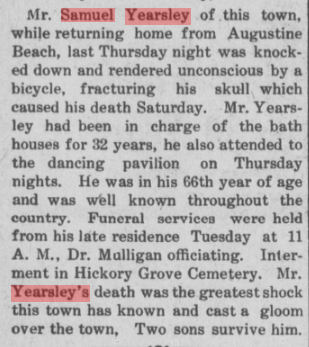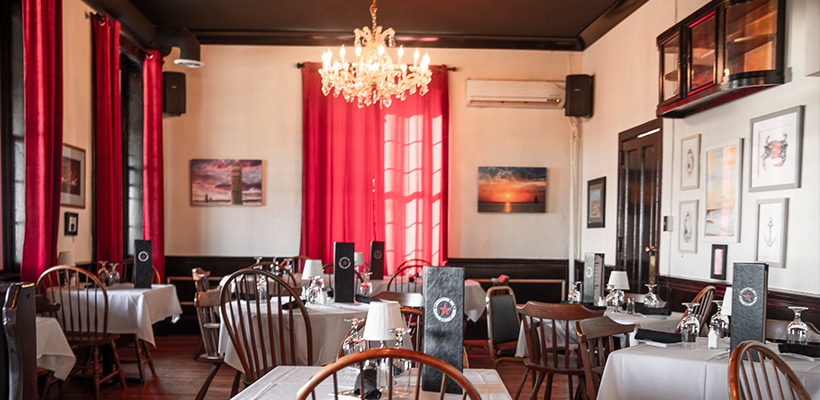The Augustine Beach Hotel, now known as the Augustine Inn, has witnessed its fair share of paranormal experiences. With its long history, it is not surprising that there have been reports of ghostly encounters and unexplained phenomena.
In 2020, the owners of the Inn invited DSGI to provide a bit of paranormal “entertainment” after dinner. Little did the patrons know that some entertainment is not for the faint of heart.
The location of the Inn is important because of its proximity to the water, wildlife refuge and relative seclusion. This area is south of Port Penn on Delaware Route 9, though the street address is Saint Augustine Road in Middletown, Delaware. Route 9 was one of the primary paths of the Underground Railroad. Its purpose was to aid enslaved individuals in their quest for freedom within the United States.
Diamond State Ghost Investigators president Gina Dunham always tells us there is no sense in trying to understand any sort of paranormal phenomenon without knowing the history of where we are investigating. Sometimes half the team goes into locations without knowing the history, while the other half is familiar. This makes the evidence debrief interesting in the end to be less biased.
The History of Augustine Beach Hotel
It was built around 1814 by Adam Diehl, a successful cattle farmer who arrived in the Port Penn area in the 1790s. In my research, I’ve read that Diehl named the hotel after Augustine Herman, a notable figure in Delaware’s history. But…. I have also found information saying that Augustine Herman’s son, Casparus Herman, acquired the land and named the area after his father. Casparus built a manor house on the site, which was later replaced with the Augustine Beach Hotel in 1814 by Diehl.
Herman, a Bohemian explorer and cartographer, agreed to map the region for Lord Calvert in exchange for a 20,000-acre estate. Bohemia Manor’s estate touched the Delaware at its eastern end and included Augustine Beach. An interesting factoid regarding the Herman family is that they were not from the United States. They came over from the New-Netherlands/New Amsterdam. He became the first naturalized citizen of Maryland by order of Cecil Calvert, Second Lord Baltimore. The Naturalization Act included him, his children and his brother-in-law. His wife had died earlier. He remarried once in the States.
The Land near Augustine Beach
I’ve found information about Augustine Herman trading with Native Americans, but I have to wonder about the land on which he settled. Herman originally came to the U.S. on a diplomatic mission to New England to resolve concerns about rumors of a Dutch & Native American alliance against the English. Knowing that much of the Lenape Tribes of Delaware had their land stolen, I am curious if this land is part of that betrayal.
Augustine Beach is located in the ancestral homeland of the Lenni-Lenape people. The link shared states that Augustine Herman was given 30,000 acres, not 20k, and that part of it was indeed tribal land. Given the fact that the land was given to Herman by someone other than a tribe member, my guess is the Lenni-Lenape community did not freely give their land away.
Dancing, bathhouses and race tracks
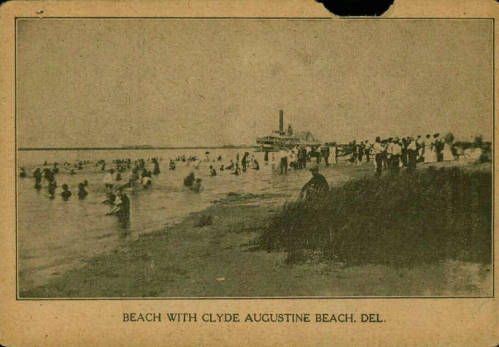
For a good forty years, the Augustine Beach Hotel was said to be a top-notch resort area. People hosted parties, took class trips, held church picnics and went out dancing during the hotel’s open season. Many visitors arrived on the steamship Thomas Clyde from Philadelphia.
For those local to the area, regular print advertisements discussed first-class meals and dancing. The ad shown here was published in the Newark Post on August 12, 1914. You can see it highlights the fine bathing and new sanitary bathhouses. There was a time when bathhouses were considered critical for public health, an amenity considered necessary for people who wanted to host big, lavish beach parties. They provided convenience, hygiene, and social space for visitors to enjoy their time at the beach.
Despite changes in management, the advertisements continued to feature dancing. One such ad, found in the Smyrna Times on November 29, 1945, advertised a 5-piece orchestra performing every Saturday night. The establishment’s patrons were known to be of high social status and were able to enjoy various attractions such as a miniature steam engine train, a merry-go-round, and a shuffleboard.
An article published in The News Journal in 2007 quoted then-92-year-old Thelma Bendler, who remembered a hurricane in the 1930s with flood waters so deep that she could dive into the river from the porch of the Augustine Inn.
When the article was published, Bendler’s neighbor, Bill Marshall, 67, remembered when there was a stock-car track near the Augustine Inn, where men would race their 1937 and ’38 Fords.
The 1940s brought more change to Augustine Beach: A boardwalk and an amusement pier filled with rides.
Death by the beach
There are many conflicting reports about the deaths that took place at this location over the last century. Some of these are riddled with gossip pertaining to gangs, bootleggers and underground railroad lore. I’ve heard stories about little girl ghosts and cantankerous previous owners, but finding the details has proven fruitless.
There are confirmed cases of drownings at the beach and bodies being washed ashore. Even a confirmed case of a man who died from being poisoned. Charles Vile, age 25, was a passenger on a steamboat heading to the resort on July 24, 1916. Reports claim he got on the boat healthy, and by the time they reached the pier, he was violently ill. He died the following day. The article says he had several beers on the excursion, and the theory is that the beers are how he was poisoned.
One news article published in the Evening News Wilmington Daily Commercial on August 2, 1915, shares the death of Mr. Yearsley, who died due to a “concussion of the brain” received after being knocked down by a bicycle in the front of the hotel. Though only two paragraphs, the article paints a rather racist picture of what happened. This is a stark reminder of how difficult it is to report on past events because the media’s portrayal is heavily, openly biased the further back you go in time.
A follow-up article published in the Middletown Transcript on August 4, 1915, said the cyclist had not been traced. His obituary was published on August 7 in the Transcript, and it stated that Yearsley had worked at the hotel, specifically in charge of the bathhouses, for 32 years.
Historical Research Matters
When doing historical research for paranormal investigations, it’s always interesting to find stories like these. Here we have a man who devoted decades of his life to working at the hotel. He was then killed outside the hotel, and the person responsible was not caught. Samuel Yearsley is a name I would ask about while investigating.
The property’s history is crucial to understanding anything paranormal occurring on the grounds.
By 1918, the Augustine Beach Hotel was leased by the government and turned into quarters for the United States Army officers connected to the new Port Penn Plant.
In 1963, the state Board of Health closed the beach due to bacterial pollution, and the hotel was sold by sheriffs sale.
This property was added to the National Register of Historic Places in 1973.
Current Day
The Inn’s history is fraught with mystery and despair, hope and freedom, celebration and death. There are likely countless stories we’ll never know about. Perhaps other stories are told by word of mouth, which we can’t prove with documentation.
While the property hasn’t offered room rentals since the 1940s, it has operated as a taproom, bike bar and a VFW post before shutting down and undergoing renovations, turning it into an upscale restaurant.
I learned that a previous bartender, Harry Pressell, Jr. ran the establishment as a biker bar before passing in 2010. He was a member of ABATE of Delaware, a Motorcyclists’ Rights Organization. His obituary tribute wall makes him sound well-loved by his biker tribe. There is an inactive Facebook page that had posted about Harry pretty regularly. One post shows a plaster mask sitting on the mantel of a fireplace. Some say he died in front of this fireplace, but I have not found published evidence of that. The Facebook post says he used to sleep near this fireplace, so it’s possible he could have passed here.
Augustine Inn Seafood and Chop House
In 2020, the owners of Augustine Inn Seafood and Chop House wanted to entertain those visiting for food and drinks. The ambiance inside the establishment was warm and inviting. They often had live music performed by local talent. They served delicious food and, at times, offered the opportunity for folks to eat, followed by a paranormal investigation. The Diamond State Ghost Investigators were happy to have the chance to investigate this property. We only wish the walls could talk upstairs and in the basement.
The owners we worked with closed their doors to bring the same great food, service, and happy hour to the town of Middletown in the form of Metro Steak and Seafood.
I read that the Inn opened again under new management in October 2022, but I don’t know about the new owners.
Is the Augustine Inn Haunted?
If you try searching the Googles for evidence of ghosts on Augustine Beach or at the Inn, you’ll not find much. The paranormal history of St. Augustine, Florida, is documented pretty well, and it dominates the results. I can only speak of my limited experience
In the basement, I recall seeing shadows moving through our laser grid. We use grids to detect movement and shadows that may not be visible to the naked eye. Sometimes when rooms are incredibly dark, standing back and watching a grid is helpful. Since the darkness can play tricks on your eyes, you should use more than one type of tool while investigating. Several of the guests we investigated also used dowsing rods. We typically also use recorders to pick up sounds we might not hear until later when listening back, but in this case, recordings wouldn’t have been helpful. You need to have a quiet space with minimal interference in the environment if you want a true EVP session with a recording.
According to Delaware Today, the Augustine Inn is one of Delaware’s most haunted places. With dozens of people (who had just imbibed) in small spaces, conducting a proper investigation is hard, so I can’t say we have enough evidence to vault away for this location.
With its long history, it is not surprising that there have been reports of ghostly encounters and unexplained phenomena. Visitors and staff have reported hearing footsteps, seeing apparitions, and experiencing strange occurrences
I feel confident in saying this property is haunted. It has seen too much.




